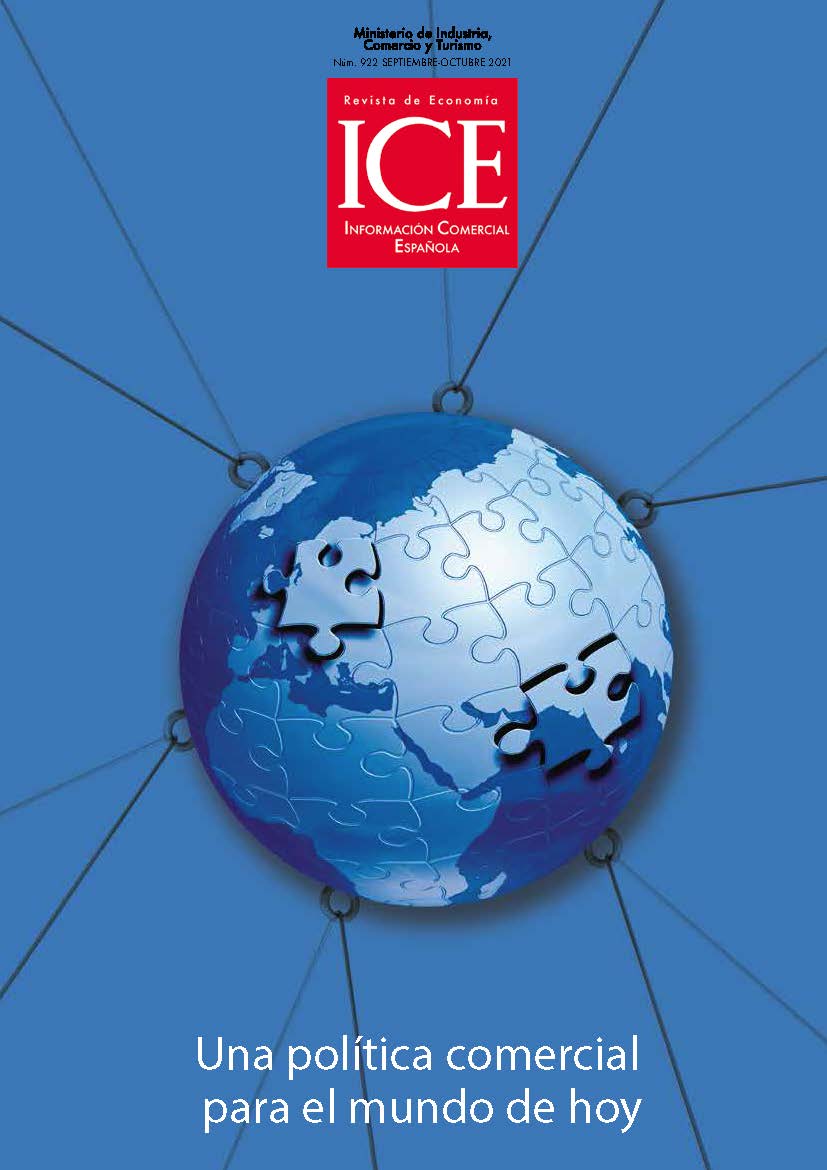Evolución de la intensidad tecnológica y ventajas comparativas de las exportaciones de manufacturas españolas durante el periodo 2000-2018
##plugins.themes.bootstrap3.article.sidebar##
Descargas
##plugins.themes.bootstrap3.article.main##
Este estudio analiza la evolución de la intensidad tecnológica de las exportaciones españolas de manufacturas durante el periodo 2000-2018, concluyendo que los resultados no han sido muy satisfactorios en relación con la mejora del componente tecnológico de las exportaciones españolas. Asimismo, se analizan las ventajas comparativas de las principales manufacturas con mayor intensidad tecnológica, con el fin de que sirva de ayuda en la elección de sectores estratégicos dentro de la nueva estrategia PASE.
##plugins.themes.bootstrap3.article.details##
Aiginger, K. & Falk, M. (2005). Explaining Differences in Economic Growth among OECD Countries. Empirica, 32(1), 19-43.
Balassa, B. A. (1965). Trade liberalization and “revealed” comparative advantage. The Manchester School of Economic and Social Studies, 33(2), 99-123.
Braunerhjelm, P. & Thulin, P. (2008). Can Countries Create Comparative Advantages? R&D Expenditures, High-tech Exports and Country Size in 19 OECD Countries, 1981-1999. International Economic Journal, 22(1), 95-111.
Ceglowski, J. (2017). Assessing Export Competitiveness Through the Lens of Value Added. The World Economy, 40(2), 275-296.
Chor, D. (2010). Unpacking sources of comparative advantage: A quantitative approach. Journal of International Economics, 82(2), 152-167.
Costinot, A., Donaldson, D. & Komunjer, I. (2012). What goods do countries trade? A quantitative exploration of Ricardo’s Ideas. Review of Economic Studies, 79(2), 581-608.
Costinot, A., Donaldson, D., Vogel, J. & Werning, I. (2015). Comparative advantage and optimal trade policy. Quarterly Journal of Economics, 130(2), 659-702.
Crespo, J. & Wörz, J. (2005). On Export Composition and Growth. Review of World Economics, 141(1), 33-49.
Dalum, B., Laursen, K. & Villumsen, G. (1998). Structural Change in OECD Export Specialisation Patterns: De-specialisation and ‘Stickiness’. International Review of Applied Economics, 12(3), 423-443.
De Benedictis, L. & Tamberi, M. (2004). Overall Specialization Empirics: Techniques and Applications. Open Economies Review, 15(4), 323-346.
Deb, K. & Basu, P. (2011). Indices of Revealed Comparative Advantage and their Consistency with the Heckscher-Ohlin Theory: A Cross Sectional Analysis. Foreign Trade Review, 46(3), 3-28.
Donoso, V. & Martín, V. (2017). Complejidad económica y densidad productiva como fuentes de competitividad. Estudios de Economía Aplicada, 35(1), 85-110.
Eaton, J. & Kortum, S. (2002). Technology, Geography, and Trade. Econometrica, 70(5), 1741-1779.
Falk, M. (2009). High-Tech Exports and Economic Growth in Industrialized Countries. Applied Economics Letters, 16(10), 1025-1028.
González Pandiella, A. (2015). A Constant market Share Analysis of Spanish Goods Exports. OECD, Economics Department Working Papers No. 1186.
Granstrand, O. (1998). Towards a Theory of the Technology-Based Firm. Research Policy, 27 (5), 465-489.
Hausmann, R., Hwang, J. & Rodrik, D. (2007). What You Exports Matters. Journal of Economic Growth, 12(1), 1-25.
Helper, S., Krueger, T. & Wial, H. (2012). Why does manufacturing matter? Which manufacturing matters? A policy framework. Brookings Metropolitan Policy Program.
Hoen, A. R. & Oosterhaven, J. (2006). On the Measurement of Comparative Advantage. The Annals of Regional Science, 40(3), 677-691.
Jarreau, J. & Poncet, S. (2012). Export Sophistication and Economic Growth: Evidence from China. Journal of Development Economics, 97(2), 281-292.
Klotz, S., Kniahin, D. & Jansen, M. (2016). ITC assessment of the technology level of exports: methodology and analytical issues. International Trade Center, Working Papers Series No. WP-01-2016.E.
Lafay, G. (1987). Avantage comparatif et compétitivité. Économie Prospective Internationale, 29, 39-52.
Laursen, K. (2015). Revealed comparative advantage and the alternatives as measures of international specialization. Eurasian Business Review, 5(1), 99-115.
Leromain, E. & Orefice, G. (2014). New revealed comparative advantage index: Dataset and empirical distribution. International Economics, 139, 48-70.
Minondo, A. (2007). ¿Cuál es el Grado de Sofisticación de las Exportaciones Manufactureras Españolas? Estudios de Economía Aplicada, 25(3), 643-654.
Minondo, A. (2010). Exports´ Quality-Adjusted Productivity and Economic Growth. Journal of International Trade and Economic Development, 19(2), 257-287.
Myro, R. (2013). La Política de Internacionalización de la Empresa Española. Economía Industrial, 387, 119-130.
Myro, R. (2020). La industria española después de la pandemia. Información Comercial española (ICE), Revista de Economía, 919, 41-62. https://doi.org/10.32796/ice.2021.919.7172
Pelinski, A., do Carmo, A. S. S. & Stege, A. L. (2017). The effect of technological Intensity of Exports on the Economic Growth of Brazilian Microregions: A Spatial Analysis with Panel Data. EconomiA, 18(3), 310-327.
Proudman, J. & Redding, S. (1998). Openness and growth: proceedings of the Bank of England academic conference on the relationship between openness and growth in the United Kingdom, September 15th, 1997. UK: Bank of England.
Rodil, O., Vence, X. & Sánchez, M. C. (2015). El comercio bilateral entre España y sus socios europeos desde una perspectiva de intensidad tecnológica. Revista de Economía Mundial, 39, 109-142.
Rodrik, D. (2006). What Is So Special About China´s Exports? China and the World Economy, 14(5), 1-19.
Shubbak, M. H. (2019). The technological system of production and innovation: The case of photovoltaic technology in China. Research Policy, 48(4), 993-1015.
Srholec, M. (2007). High-Tech Exports from Developing Countries: A Symptom of Technology Spurts or Statistical Illusion? Review of World Economics, 143(2), 227-255.
Stellian, R. & Danna-Buitrago, J. (2019). Revealed comparative advantages and regional specialization: Evidence from Colombia in the Pacific Alliance. Journal of Applied Economics, 22(1), 349-379.
Velasco, R. (2014). Salvad la industria española: desafíos actuales y reformas pendientes. La Catarata.
Velasco, R. & Plaza, B. (2003). La industria española en democracia, 1978-2003. Economía Industrial, 349(350), 155-180.
Wierts, P., Van Kerkhoff, H. & De Haan, J. (2014). Composition of Exports and Exports performance of Eurozone Countries. Journal of Common Markets Studies, 52(4), 928-941.
Xifré, R. (2020). Las exportaciones españolas de alta tecnología. Cuadernos de Información Económica, 278, 69-75.
Yu, R., Cai, J. & Leung, P. (2009). The Normalized Revealed Comparative Advantage Index. The Annals of Regional Science, 43(1), 267-282.


